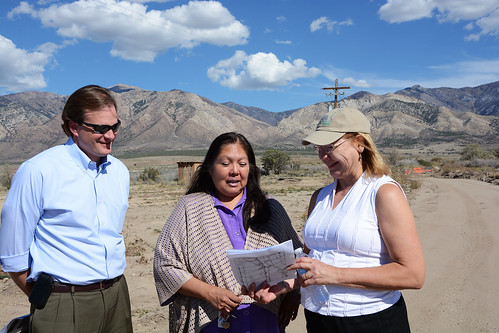
A massive wildfire followed by heavy rains greatly damaged the landscape of a Utah valley, home to the Skull Valley Band of the Goshute Indian Tribe. The natural disasters broke water delivery systems and disrupted vital community infrastructure.
Recently, the band’s leadership met with USDA officials to find solutions on how they could recover and prevent future flooding events.
At a StrikeForce for Rural Growth and Opportunity meeting held in Tooele near the reservation, Tribal Chairwoman Lori Bear and Vice Chairwoman Kristen Bear-Stewart took the opportunity to share with USDA Under Secretary Robert Bonnie and Deputy Under Secretary Ann Bartuska some challenges they face on the reservation. The USDA officials also toured the flood-damaged area.
“We need water for our crops and our buffalo herd,” Bear said.
Bonnie talked about how the tribe could seek Emergency Watershed Protection Program funding through USDA’s Natural Resources Conservation Service. With this funding, water diversions and catchment basins could be constructed and installed that would divert flood waters from the restored irrigation delivery systems.
Bartuska encouraged the tribal leaders to consider some of the community services available through the USDA agencies represented at the meeting.

Other USDA leaders spoke about other assistance available to the tribe through the 2014 Farm Bill, such as seasonal high tunnels, which extend the growing season for community vegetable production. NRCS offers technical and financial assistance to farmers wanting to build seasonal high tunnels.
“With all the resources we’ve talked about – it’s amazing,” Bear said. She said she plans to discuss these new opportunities with the Tribal Council.
The 18,000-acre reservation is located about 70 miles southwest of Salt Lake City.
Although drinking water has been restored, both tribal and USDA agency leaders agreed the first priority is to protect the area from future flooding. Temporary flood barriers have already been placed around the reservation’s small community of tribal members. Tribal leaders also want to restore the community’s washed-out irrigation system used for watering their crops and vegetable gardens, and conveying water to their Buffalo herd.
They saw first-hand the debris fields left in the wake of flooding. Visitors could see where massive rock and sediment flows covered the land. A ruptured water pipe was visible providing evidence of their disrupted water supply and way of life.
The StrikeForce for Rural Growth and Opportunity addresses high-priority funding and technical assistance needs in rural communities in 20 states, including Utah. It provides an opportunity for NRCS to work with underserved landowners to determine how to best leverage available financial assistance to address their natural resource concerns, with an emphasis on historically underserved communities in rural counties with persistent poverty.

